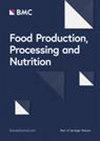物理化学特性,食用和烹饪品质和遗传变异:对印度南部选定水稻品种的比较分析
IF 5.7
3区 农林科学
Q2 FOOD SCIENCE & TECHNOLOGY
引用次数: 0
摘要
摘要水稻的理化特性和消化特性受其遗传变异的影响很大。在这项研究中,我们试图了解喀拉拉邦五种传统和普遍消费的大米品种的整体质量。测定了直链淀粉含量(AC)、凝胶浓度(GC)和糊化温度(GT)等影响大米食煮品质的主要性状,并与淀粉合成相关基因(SSRGs)的表达进行了相关性分析。Wx是一种主要的SSRG,它调节直链淀粉含量和大米的食用和烹饪品质。Jaya、Matta和Rakthashali品种直链淀粉含量中等,而Kuruva和Pokkali品种直链淀粉含量较高。所有品种的血糖指数(GI)均在51.0 ~ 58.6之间。在筛选的水稻品种中,Pokkali的血糖指数和消化率最低,食用和烹饪品质都很好。低GI(51.0)的Pokkali大米可以作为糖尿病治疗的推荐品种。此外,通过淀粉合成相关基因(Wx)的表达调控水稻的食煮品质和植物育种技术,可能是改良这一珍贵种质的新途径。图形抽象本文章由计算机程序翻译,如有差异,请以英文原文为准。
Physicochemical properties, eating and cooking quality and genetic variability: a comparative analysis in selected rice varieties of South India
Abstract The physicochemical characteristics and digestibility properties of rice are greatly influenced by its genetic variability. In this study, we attempt to understand the overall quality of five traditional and popularly consumed rice varieties of Kerala. The major traits affecting the eating and cooking quality of rice such as amylose content (AC), gel consistency (GC) and gelatinization temperature (GT) were determined and correlated with the expression of the starch-synthesis-related genes (SSRGs). The Wx is a major SSRG, which modulates the amylose content and the eating as well as cooking qualities of rice. The rice varieties including, Jaya, Matta and Rakthashali were found to have intermediate amylose content ( Wx a allele) while Kuruva and Pokkali were found to have high Amylose Content ( Wx a allele). The glycemic index (GI) of all varieties was found to be in the range of 51.0–58.6. Among the screened rice varieties, Pokkali was found to have the lowest glycemic index and digestibility with appreciable eating and cooking qualities. Pokkali rice, with its low GI (51.0), could be a recommended variety for diabetes management. Furthermore, the rice eating and cooking qualities, and plant breeding techniques coordinated by the expression of the starch synthesis-related gene ( Wx ), could be a novel approach to improve the valuable germplasm. Graphical Abstract
求助全文
通过发布文献求助,成功后即可免费获取论文全文。
去求助
来源期刊

Food Production, Processing and Nutrition
Medicine-Public Health, Environmental and Occupational Health
CiteScore
6.90
自引率
4.30%
发文量
28
审稿时长
12 weeks
 求助内容:
求助内容: 应助结果提醒方式:
应助结果提醒方式:


